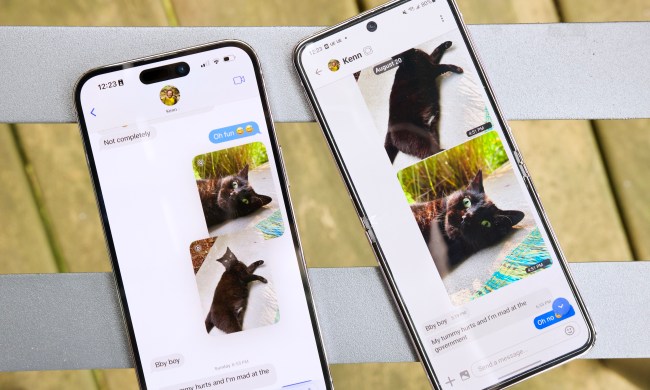
The Honor 20 is a great little phone. It’s lightweight, has a decent camera, comes in a shiny color, and isn’t all that expensive. Despite this, not only is it difficult to recommend, but I also question why it needs to exist at all. I have no doubt there are many justifiable business reasons behind it, but when the Honor 20 Pro and Honor 20 Lite seem to give us all we need, the standard Honor 20 feels redundant.
Design
The Honor 20 is similar to the Honor 20 Pro in many ways. It has the same size 6.26-inch LCD screen with a hole-punch selfie camera in the top left, as well as the Kirin 980 processor powering the Android 9.0-based Magic UI 2.0 operating system. There’s a little less RAM at 6GB (which is still plenty), you only get up to 128GB of storage, and the battery has a smaller 3,750mAh capacity. It’s a smaller cell, but battery life is still strong; it lasts without a problem from early in the morning to late at night, even with heavy use.
Alterations come in all the places where we don’t want compromises to be made: the design and camera. Appearance-wise, the Honor 20 is closer to the Honor 20 Lite than the 20 Pro. It has a flat rear panel, unlike the wonderful curve of the Pro model, which lessens the visual impact of the so-called Dynamic Holographic Design. This refers to the reflective effect on the back, where ripples of color appear to sit deep below the surface of the phone. It’s effective on the 20 Pro, but not as eye-catching on the flat Honor 20. Just to be clear, it’s not an ugly design. The Honor 20 is pretty enough for a mid-range 2019 phone, it just doesn’t stand out.
On the other ergonomic end of the spectrum, the side-mounted fingerprint sensor is excellent.
The less curvy body makes the phone more uncomfortable to hold; I found myself gripping it too much, out of fear it would slip out of my hand. On the other ergonomic end of the spectrum, the side-mounted fingerprint sensor is excellent. It’s fast and reliable, while being easy to locate even when not looking at the phone. You’ll find the same to be true on the Honor 20 Pro. The hole-punch camera continues to be a brilliant feature, as it effectively disappears when playing games in landscape orientation, and is small enough not to be intrusive or distracting at other times.
Honor has made the body 7.8mm thick and 174 grams in weight, so it does easily disappear in your pocket. This is the confusing part of the Honor 20 — it’s compact, light, looks fine, and is well made. But it’s noticeably less interesting than the Honor 20 Pro, and not as pleasant to handle.
Camera
Honor has dropped the telephoto zoom feature on the Pro model for the Honor 20, replacing it with a 2-megapixel depth sensing sensor. This makes the camera less versatile than with the 8-megapixel telephoto lens, and unable to match the impressive zoom capabilities. But it can still take some really excellent photos. Blue skies and green fields pop with the excitement we’re used to seeing on Huawei and Honor phones, due to the artificial intelligence often boosting contrast and saturation in these scenarios. There’s no doubt they look shareable straight off the camera.
Night mode is great, capturing realistic colors with an effective white balance for natural-looking low-light photos. Like the Honor 20 Pro, there were a few problems with focusing and over-exposure of overcast skies, but this is likely a software issue that will be cured in the future. Despite not being able to zoom in as close as the 20 Pro, the 2x zoom and the wide-angle camera are fun, and the photos they enable you to take add plenty of creativity to the phone’s camera. But when the Honor 20 Pro is available, with even more features and stronger performance, you’re better served buying that phone. It has to last you a couple of years, so why not get the best?
Software and performance
Because internally the Honor 20 is basically the same as the Honor 20 Pro, the same downsides exist with the software. Notifications aren’t always very reliable, and interacting with them in the Notification Shade is problematic; the lack of an AMOLED-enabled, always-on screen means they’re not always noticed either. There are too many pre-installed apps, including Amazon Alexa as an alternative voice assistant to Google Assistant.

Visually Magic UI 2.0 (as with the almost identical EMUI software found on Huawei phones) is messier than Android on the Google Pixel 3a, for example. But in my time using the Honor 20, it has been swift, smooth, and trouble-free experience. I always recommend following a few steps during setup to make EMUI and Magic UI 2.0 more usable straight away.
The performance is helped by the top-of-the-range Kirin 980 processor, which is a star inside the Honor 20 Pro and the Huawei P30 Pro too. I experienced no problems playing games or carrying out everyday tasks on the Honor 20. A series of benchmark tests show the Honor 20’s performance.
Here’s the Honor 20’s obvious advantage over the competition: It has a monster processor, and delivers a stronger overall performance than similarly-priced phones. But I never noticed the Honor 20 being so much faster than the Pixel 3a, and although the fast chip will ensure the phone remains powerful for the coming years, it’s paired with a lesser camera than the equally-capable Honor 20 Pro.
What about concerns over the future of Android system updates for the Honor 20 (and Honor 20 Pro)? They’re unjustified, according to Honor, which has repeatedly stated the 20 Series is Google-certified. Plus an inside source recently told Digital Trends the Honor 20 Series is on track to get Android Q in the future. While the situation with Huawei and its presence on the U.S.’s Entity List has not yet been resolved, the company is going out of its way to reassure you that all is well with the Honor 20 family.
Conclusion
Yes, the Honor 20 is a good phone, and at 400 British pounds (about $505) it’s decent value and goes directly up against the Google Pixel 3a in the U.K.. The Honor 20 Pro will be 550 pounds (about $695) when it eventually goes on sale, making it more expensive but more exciting and with a more attractive design. This means it will last longer in your ownership.
The cheaper Honor 20 Lite — which has a downgraded camera system without the 48-megapixel sensor, and a Kirin 710 processor — is only 250 pounds. If you can’t justify the price of the Honor 20 Pro, save money and buy the Honor 20 Lite. Or, and this is probably better advice, buy the Motorola One Vision, the Google Pixel 3a, or push the budget and get the Zenfone 6 or Xiaomi Mi 9.
That’s the problem here. The Honor 20 isn’t as good as the Honor 20 Pro, not as cheap as the Honor 20 Lite, and not as desirable as other new smartphones that are available for similar prices. There’s nothing fundamentally wrong with it, and you won’t be disappointed by any aspect should you decide to buy it. Just know a better version that will last you longer is (almost certainly) coming next month, and there are other (better) alternative choices we’d recommend more on sale today.
The Honor 20 is available through Honor’s online store in the U.K., Amazon, the Three network, and Carphone Warehouse retail stores. It has not been announced for the U.S..












